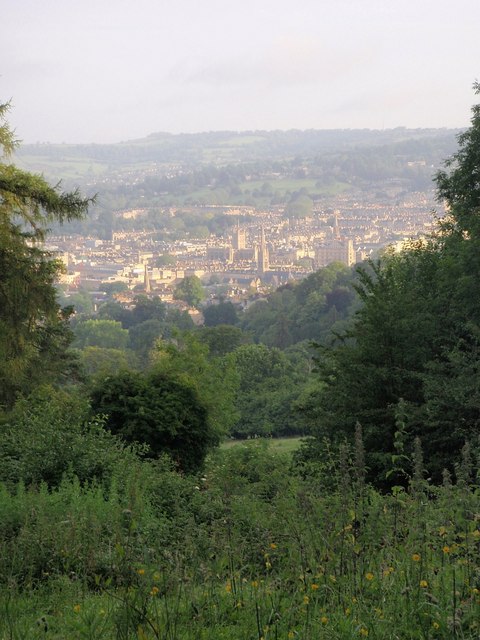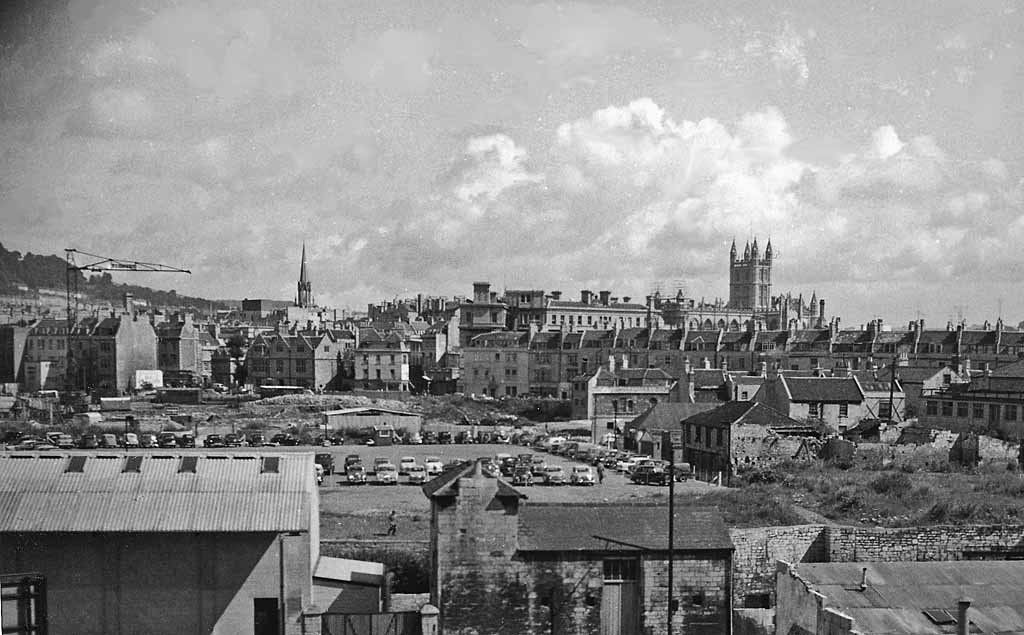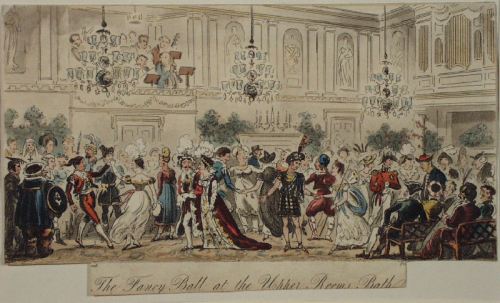|
Bath, Somerset
Bath (Received Pronunciation, RP: , ) is a city in Somerset, England, known for and named after its Roman Baths (Bath), Roman-built baths. At the 2021 census, the population was 94,092. Bath is in the valley of the River Avon, Bristol, River Avon, west of London and southeast of Bristol. The city became a UNESCO World Heritage Site in 1987, and was later added to the transnational World Heritage Site known as the "Great Spa Towns of Europe" in 2021. Bath is also the largest city and settlement in Somerset. The city became a spa with the Latin name ' ("the waters of Sulis") 60 AD when the Romans built Roman Baths (Bath), baths and a temple in the valley of the River Avon, although List of geothermal springs in the United Kingdom, hot springs were known even before then. Bath Abbey was founded in the 7th century and became a religious centre; the building was rebuilt in the 12th and 16th centuries. In the 17th century, claims were made for the curative properties of water ... [...More Info...] [...Related Items...] OR: [Wikipedia] [Google] [Baidu] |
Pulteney Bridge
Pulteney Bridge is a bridge over the River Avon (Bristol), River Avon in Bath, Somerset, Bath, England. It was completed by 1774, and connected the city with the land of the Pulteney family which the family wished to develop. Designed by Robert Adam in a Palladian architecture, Palladian style, it is highly unusual in that it has shops built across its full span on both sides. It has been designated as a Grade I listed building. Within 20 years of its construction, alterations were made that expanded the shops and changed the façades. By the end of the 18th century, it had been damaged by floods, but was rebuilt to a similar design. Over the next century alterations to the shops included cantilevered extensions on the bridge's north face. In the 20th century, several schemes were carried out to preserve the bridge and partially return it to its original appearance, enhancing its appeal as a tourist attraction. The bridge is now long and wide. Although there have been plans ... [...More Info...] [...Related Items...] OR: [Wikipedia] [Google] [Baidu] |
Georgian Era
The Georgian era was a period in British history from 1714 to , named after the House of Hanover, Hanoverian kings George I of Great Britain, George I, George II of Great Britain, George II, George III and George IV. The definition of the Georgian era is also often extended to include the relatively short reign of William IV, which ended with his death in 1837. The subperiod that is the Regency era is defined by the regency of George IV as Prince of Wales during the illness of his father George III. The transition to the Victorian era was characterized in religion, social values, and the arts by a shift in tone away from rationalism and toward romanticism and mysticism. The term ''wikt:Georgian, Georgian'' is typically used in the contexts of social and political history Georgian architecture, and architecture. The term ''Augustan literature'' is often used for Augustan drama, Augustan poetry and Augustan prose in the period 1700–1740s. The term ''Augustan'' refers to the ac ... [...More Info...] [...Related Items...] OR: [Wikipedia] [Google] [Baidu] |
Bath Skyline
Bath Skyline is a circular trail that affords views of the historic city of Bath in England. It is managed by the National Trust. Route The trail is located on high ground to the east of the city centre of Bath, a World Heritage Site, allowing unique views of the city and its buildings. It is in length. The route passes through or near numerous landmarks including Bathwick Hill, Bathampton Down, Prior Park Landscape Garden, Richens Orchard, Smallcombe Cemetery, Bathampton Woods and Sham Castle. The Iron Age The Iron Age () is the final epoch of the three historical Metal Ages, after the Chalcolithic and Bronze Age. It has also been considered as the final age of the three-age division starting with prehistory (before recorded history) and progre ... fort on Little Solsbury Hill is also visible from the route. Part of the trail has been adapted in order to be accessible to wheelchairs. Facilities The route is managed, with hedges and trees cut to ensure they do no ... [...More Info...] [...Related Items...] OR: [Wikipedia] [Google] [Baidu] |
Tourism In England
Tourism plays a significant part in the economy of England. In 2018, the United Kingdom as a whole was the world's 10th most visited country for tourists, and 17 of the United Kingdom's 25 UNESCO World Heritage Sites fall within England. VisitEngland is the official tourist board for England. VisitEngland's stated mission is to build England's tourism product, raise Great Britain, Britain's profile worldwide, increase the volume and value of tourism exports and develop England and Britain's visitor economy. In 2020, the ''Lonely Planet'' travel guide rated England as the second best country to visit that year, after Bhutan. Lockdowns necessitated by the COVID-19 pandemic significantly reduced the number of visitors in 2020-2022, a 10-day quarantine period applied to people entering England from a number of "red list" countries. Cities The 15 English cities visited most by overseas tourists in 2019 were:Section 4, Figure 9, Rankings Unlike other countries, most state-run m ... [...More Info...] [...Related Items...] OR: [Wikipedia] [Google] [Baidu] |
Avon (county)
Avon ( ) was a Shire county, non-metropolitan and ceremonial counties of England, ceremonial county in the west of England that existed between 1974 and 1996. The county was named after the River Avon (Bristol), River Avon, which flows through the area. It was formed from the county boroughs of County Borough of Bristol, Bristol and County Borough of Bath, Bath, together with parts of the Administrative counties of England, administrative counties of Gloucestershire and Somerset. In 1996, the county was abolished and the area split between four new unitary authorities: Bath and North East Somerset, City of Bristol, Bristol, North Somerset and South Gloucestershire. The Avon name is still used for some purposes. The area had a population of approximately 1.08 million people in 2009. Background The port of Bristol lies close to the mouth of the River Avon which formed the historic boundary between Gloucestershire and Somerset. In 1373, a charter constituted the area as the Coun ... [...More Info...] [...Related Items...] OR: [Wikipedia] [Google] [Baidu] |
Bath Blitz
The term Bath Blitz refers to the air raids by the German ''Luftwaffe'' on the British city of Bath, Somerset, during World War II. The city was bombed in April 1942 as part of the so-called " Baedeker raids", in which targets were chosen for their cultural and historical, rather than their strategic or military, value. Background Bath was subject to numerous air raid warnings during the Blitz, the German night bombing offensive against Britain's cities, as raiders flew overhead on their way to nearby Bristol which was bombed severely throughout the period, and several bombs fell on Bath during 1940 and 1941. However, the city remained largely untouched until April 1942 and the start of the Baedeker Blitz, mounted in response to a step-change in the effectiveness of the RAF's bombing offensive in March 1942 which resulted in the destruction of the city of Lübeck. The Blitz Over the weekend of 25–27 April 1942, Bath suffered three raids from 80 ''Luftwaffe'' aircraft ... [...More Info...] [...Related Items...] OR: [Wikipedia] [Google] [Baidu] |
Jane Austen
Jane Austen ( ; 16 December 1775 – 18 July 1817) was an English novelist known primarily for #List of works, her six novels, which implicitly interpret, critique, and comment on the English landed gentry at the end of the 18th century. Austen's plots often explore the dependence of women on marriage for the pursuit of favourable social standing and economic security. Her works are implicit critiques of the sentimental novel, novels of sensibility of the second half of the 18th century and are part of the transition to 19th-century literary realism. Her use of social commentary, realism, wit, and irony have earned her acclaim amongst critics and scholars. Austen wrote major novels before the age of 22, but she was not published until she was 35. The anonymously published ''Sense and Sensibility'' (1811), ''Pride and Prejudice'' (1813), ''Mansfield Park'' (1814), and ''Emma (novel), Emma'' (1816) were modest successes, but they brought her little fame in her lifetime. ... [...More Info...] [...Related Items...] OR: [Wikipedia] [Google] [Baidu] |
John Wood, The Elder
John Wood, the Elder (1704 – 23 May 1754) was an English architect, working mainly in Bath. In 1740 he surveyed Stonehenge and the Stanton Drew stone circles. He later wrote extensively about Bladud and Neo-Druidism. Because of some of his designs he is also thought to have been involved in the early years of Freemasonry. His notable work in Bath included: St John's Hospital, Queen Square, Prior Park, The Royal Mineral Water Hospital, the North and South Parades and The Circus. Wood also designed important buildings outside Bath, including the reconstruction of Llandaff Cathedral, Buckland House, The Exchange, Bristol, and Liverpool Town Hall. He has been described by Nikolaus Pevsner as "one of the outstanding architects of the day". Early life Wood was born in Twerton near Bath, and baptised in St. James's Church (now demolished). He received a good but basic education at King Edward's School. His father George was a local builder. During his teenage yea ... [...More Info...] [...Related Items...] OR: [Wikipedia] [Google] [Baidu] |
Beau Nash
Richard "Beau" Nash (18 October 1674 – 3 February 1762) was a Welsh lawyer who as a dandy, played a leading role in 18th-century British fashion. He is best remembered as the master of ceremonies at the spa town of Bath, Somerset. Biography Nash was born in St Mary's Street, Swansea, Wales, in 1674. His father, Richard, a native of Pembroke, had risen to be partner in a glass-works at Swansea, which - although he was "of modest means" - gave him the means to pay for his son's education. Nash's mother was a niece of the Welsh merchant John Poyer, who was mayor of Pembroke town and served during the English Civil War. The Nash family were "known" in the countryside, but the Poyer family was of "gentler blood". Nash's comparatively obscure origins were sometimes the subject of comment; when the Duchess of Marlborough mentioned it, Nash replied "Madam, I seldom mention my father in company, not because I have any reason to be ashamed of him, but because he has some reason to ... [...More Info...] [...Related Items...] OR: [Wikipedia] [Google] [Baidu] |
Bath Assembly Rooms
The Bath Assembly Rooms, designed by John Wood, the Younger in 1769, are a set of assembly rooms located in the heart of the World Heritage Site, World Heritage City of Bath, Somerset, Bath in England which are now open to the public as a visitor attraction. They are designated as a Grade I Listed building (United Kingdom), listed building. During the Georgian era Bath became fashionable, and the architects John Wood, the Elder, and his son laid out new areas of housing for residents and visitors. Assembly rooms had been built early in the 18th century, but a new venue for Ball (dance), balls, concerts and gambling was envisaged in the area between Queen Square (Bath), Queen Square, The Circus, Bath, The Circus and the Royal Crescent. Robert Adam submitted a proposal that was rejected as too expensive. John Wood, the Younger raised funding through a tontine, and construction started in 1769. The new or upper assembly rooms opened with a grand ball in 1771 and became the hub of fa ... [...More Info...] [...Related Items...] OR: [Wikipedia] [Google] [Baidu] |
Pump Room
The Grand Pump Room is a historic building in the Abbey Churchyard, Bath, Somerset, England. It is adjacent to the Roman Baths and is named because of water that is pumped into the room from the baths' hot springs. Visitors can drink the water or have other refreshments while there. It has been designated as a Grade I listed building since 1950. Along with the Lower Assembly Rooms, it formed a complex where social activity was centred, and where visitors to the city gathered. History The present building replaced an earlier one on the same site, designed by John Harvey at the request of Beau Nash, Bath's master of ceremonies, in 1706, before the discovery of Roman remains nearby. The main block, built of Bath stone, was begun by Thomas Baldwin, and the foundations of a Roman temple precinct were discovered during preparatory excavations. The North Colonnade of nine bays, with un fluted Ionic columns, was built by Baldwin in 1786–1790. Baldwin was dismissed, as a resul ... [...More Info...] [...Related Items...] OR: [Wikipedia] [Google] [Baidu] |
The Circus, Bath
The Circus is a historic ring of large townhouses in the city of Bath, Somerset, England, forming a circle with three entrances. Designed by architect John Wood, the Elder, it was built between 1754 and 1768, and is regarded as a pre-eminent example of Georgian architecture. "Circus" (Latin) means a ring, oval or circle in English. The construction has been designated as a Grade I listed building. The Circus is divided into three segments of equal length, with a lawn in the centre. Each segment faces one of the three entrances, ensuring a classical façade is always presented straight ahead. History The Circus, originally called the King's Circus, was designed by the architect John Wood, the Elder. Convinced that Bath had been the principal centre of Druid activity in Britain, Wood surveyed Stonehenge, which has a diameter of at the outer earth bank, and designed the Circus with a diameter to mimic this. Wood died less than three months after the first stone was laid ... [...More Info...] [...Related Items...] OR: [Wikipedia] [Google] [Baidu] |









